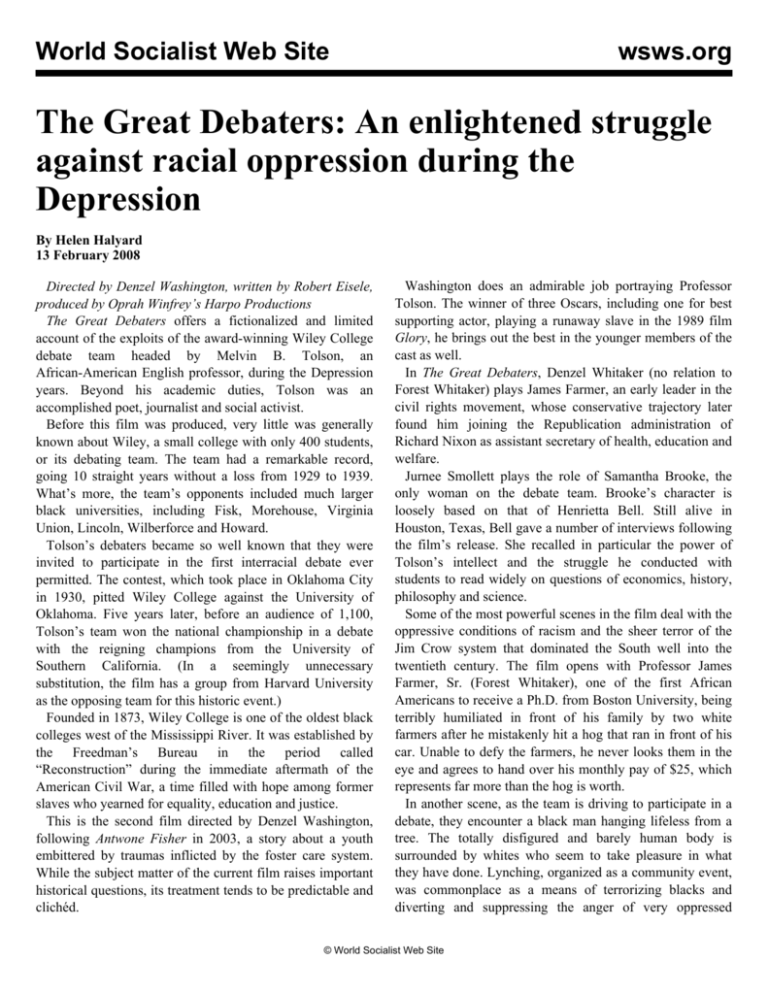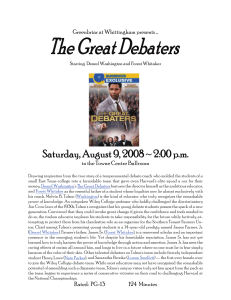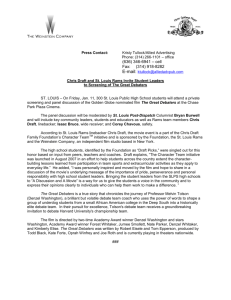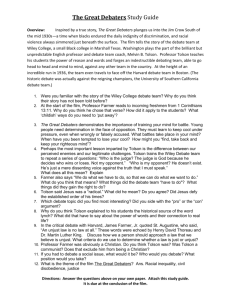The Great Debaters - International Youth and Students for Social
advertisement

World Socialist Web Site wsws.org The Great Debaters: An enlightened struggle against racial oppression during the Depression By Helen Halyard 13 February 2008 Directed by Denzel Washington, written by Robert Eisele, produced by Oprah Winfrey’s Harpo Productions The Great Debaters offers a fictionalized and limited account of the exploits of the award-winning Wiley College debate team headed by Melvin B. Tolson, an African-American English professor, during the Depression years. Beyond his academic duties, Tolson was an accomplished poet, journalist and social activist. Before this film was produced, very little was generally known about Wiley, a small college with only 400 students, or its debating team. The team had a remarkable record, going 10 straight years without a loss from 1929 to 1939. What’s more, the team’s opponents included much larger black universities, including Fisk, Morehouse, Virginia Union, Lincoln, Wilberforce and Howard. Tolson’s debaters became so well known that they were invited to participate in the first interracial debate ever permitted. The contest, which took place in Oklahoma City in 1930, pitted Wiley College against the University of Oklahoma. Five years later, before an audience of 1,100, Tolson’s team won the national championship in a debate with the reigning champions from the University of Southern California. (In a seemingly unnecessary substitution, the film has a group from Harvard University as the opposing team for this historic event.) Founded in 1873, Wiley College is one of the oldest black colleges west of the Mississippi River. It was established by the Freedman’s Bureau in the period called “Reconstruction” during the immediate aftermath of the American Civil War, a time filled with hope among former slaves who yearned for equality, education and justice. This is the second film directed by Denzel Washington, following Antwone Fisher in 2003, a story about a youth embittered by traumas inflicted by the foster care system. While the subject matter of the current film raises important historical questions, its treatment tends to be predictable and clichéd. Washington does an admirable job portraying Professor Tolson. The winner of three Oscars, including one for best supporting actor, playing a runaway slave in the 1989 film Glory, he brings out the best in the younger members of the cast as well. In The Great Debaters, Denzel Whitaker (no relation to Forest Whitaker) plays James Farmer, an early leader in the civil rights movement, whose conservative trajectory later found him joining the Republication administration of Richard Nixon as assistant secretary of health, education and welfare. Jurnee Smollett plays the role of Samantha Brooke, the only woman on the debate team. Brooke’s character is loosely based on that of Henrietta Bell. Still alive in Houston, Texas, Bell gave a number of interviews following the film’s release. She recalled in particular the power of Tolson’s intellect and the struggle he conducted with students to read widely on questions of economics, history, philosophy and science. Some of the most powerful scenes in the film deal with the oppressive conditions of racism and the sheer terror of the Jim Crow system that dominated the South well into the twentieth century. The film opens with Professor James Farmer, Sr. (Forest Whitaker), one of the first African Americans to receive a Ph.D. from Boston University, being terribly humiliated in front of his family by two white farmers after he mistakenly hit a hog that ran in front of his car. Unable to defy the farmers, he never looks them in the eye and agrees to hand over his monthly pay of $25, which represents far more than the hog is worth. In another scene, as the team is driving to participate in a debate, they encounter a black man hanging lifeless from a tree. The totally disfigured and barely human body is surrounded by whites who seem to take pleasure in what they have done. Lynching, organized as a community event, was commonplace as a means of terrorizing blacks and diverting and suppressing the anger of very oppressed © World Socialist Web Site sections of white workers. Texas was third among states, after Mississippi and Georgia, in the total number of recorded lynchings. Between 1885 and 1942, records indicate that 468 mostly black men were lynched in Texas. Another interesting episode, barely mentioned in reviews of the film, is Tolson’s effort to organize the Southern Tenant Farmers Union (STFU), a broad-based protest movement made up of black and white sharecroppers who had been driven off their land and forced into day labor. As the farmers convene a meeting to discuss their strength in unity, they come under attack from a vigilante mob. It is revealed later in the film that the local sheriff participated in the raid, along with racist organizations like the Ku Klux Klan. While The Great Debaters touches on important historical issues, very little is explained in the film about what was a tumultuous period of American history. Unless one has former knowledge of the year 1935—the height of the Great Depression in the US, a period dominated by mass unemployment, homelessness and hunger—it is not brought across in the film that it was within this context that figures like Melvin Tolson emerged. The film implies that Tolson was involved with the Communist Party. While this author could find nothing written to indicate this was the case, both the CP and Socialist Party were involved at the time in efforts to organize the STFU, and Tolson certainly would have been familiar with the perspective and political arguments advanced in their publications. One of the film’s major weaknesses is that Wiley’s debate teams always argues for what could be called the correct, or progressive, side of the issue in dispute: integration of the school system, the right of poor people to social reform, the right of masses to conduct civil disobedience against racial injustice. While debates during the 1930s were organized differently from the way they are today—where coaches agree in advance to a particular subject, and then flip a coin to see which team begins with the affirmative side—in real life, the Wiley team did not always argue for progressive positions. The film would have been strengthened and its dramatic tension increased had the team been portrayed, even once, in defense of a reactionary position. It was Tolson’s belief that the conditions of racism and inequality would be overcome through education, the power of ideas and social organization. The same convictions that drove his work with the Forensic Society of Wiley College were behind his efforts to unite black and white tenant farmers. Unfortunately, this side of the story is presented in a rather one-sided way in the film. The more prominent white actors are cast in the roles of the racist farmers, a reactionary sheriff and arrogant white student debaters. There was certainly no shortage of such reactionary layers in the Deep South during this period. And while it is true the film script had to summarize events stretching over a long period of time, the way these characters are cast is to the detriment of both historical accuracy and dramatic depth. As an example, the film portrays the audience attending the 1930 debate at the University of Oklahoma as racially polarized: the black audience applauds the Wiley debaters and the white audience applauds their home team. Contemporaneous newspaper reports, however, give a far different account. At the actual event, the audience was caught up in the strength of arguments and intellectual integrity of the participants on both sides, regardless of racial characteristics and collegiate affiliation. Tolson’s comments about the event, recorded in an article published immediately afterwards, specifically memorialize this astonishing social reality. “When the finest intellects of black youth and white youth meet,” he said, “the thinking person gets the thrill of seeing beyond the racial phenomena the identity of worthy qualities.” He went on to elaborate his vision of a moment in the future when the most eloquent and intelligent representatives of both races join forces in a united struggle against racial oppression. “For that all-too-brief hour,” he declared, “the mixed audience seemed to forget their difference, applauding one team as readily as it applauded another. In the South, I have seen the children of ex-slaves shaking hands with the grandsons of the masters after the debate.” The film would have been far more interesting had more of an effort been made by Denzel Washington and producer Oprah Winfrey to find a way to present the contradictory nature of relations. Instead—and certainly driven by the considerations of Hollywood—the film sets out to present Tolson as a brilliant middle class intellectual, generally separated from the social conditions that shaped his activities. © World Socialist Web Site To contact the WSWS and the Socialist Equality Party visit: http://www.wsws.org








